
NWO grant for research into Het Dorp: ‘We are going to tell the lesser-known history’
It is one of the most famous moments in Dutch TV history: the twenty-three hour long marathon broadcast of Open het Dorp. But what happened to the commune for people with disabilities after that? Monika Baár and Paul van Trigt received a NWO grant of 750,000 euros to map the development of Het Dorp.
‘With this project we want to tell the lesser-known history of Het Dorp,’ says Van Trigt. ‘The big fundraiser with Mies Bouwman is still part of our public memory, but few people know that Het Dorp also had an international influence.’ Baár adds: ‘After a Japanese actress saw it here it was adopted by her home country, for example.’
Global microhistory
And Japan is not the only country with its own version of Het Dorp: the concept of an accessible neighbourhood for people with disabilities has been replicated in several countries. Together with two PhD candidates, Baár and Van Trigt are going to look at how this spread took place. In addition, they want to map the local history of the neighbourhood near Arnhem by, among other things, recording the stories of residents with the help of oral history. The project is also meant to add to the safeguarding of the threatened archives and decaying historical objects of Het Dorp.
‘We want to add the history of people with disabilities to the Dutch canon using the global microhistory that will emerge from this,’ says Baár. ‘Previously, we did a global research into The International Year of Disabled Persons in 1981. Back then we noticed that the literature is very much focused on the Anglo-Saxon world, because disability studies in the Netherlands are still in their infancy. We want to change that.’
New light on the welfare state
And to that end Het Dorp is an interesting case study because it has acted as a ‘social laboratory’. ‘Some people were very happy about Het Dorp, because for the first time they could live independently, without parents or institutions,’ says Baár, ‘but others mainly felt like they couldn’t complain about such a big gift from the state, even though they sometimes had their reasons to. Initially, there were only single-person living spaces, because people couldn’t imagine that people with disabilities might also want to get married or have children. By paying attention to these negative elements we want to shed a new light on the welfare state as well as map the history of related feelings.’
Documentary
‘It is always thrilling to find out what the results of your research are,’ says Van Trigt. ‘I hope that we find surprising things, which we can also give a broader relevance.’ That is why the researchers are looking for different ways to present their results. They had previous research turned into a comic, now they want to make use of a website using simple language, like on the website DisPLACE. There will also be a documentary. ‘We are going to collaborate with Mari Sanders,’ says Van Trigt. ‘He recently made the documentary series Mari staat op for NPO 2 (Dutch television channel, ed.).’ Baár adds: ‘The coming period he will be a member of the team. We will be looking for ways in which to involve him in the research, so that he can also contribute to the content.’
Picture: Mies Bouwman hosts the fundraiser to finance Het Dorp.
